概述
netty 不是 异步io ,只是调用时候的异步 ,有事件才处理 。
- group:接收事件 你什么事件 交给一个合适的 Handler
- initChannel:里面注册Handler
- StringDecoder: 真正的处理事件的Handler 解码
- SimpleChannelInboundHandler: 真正的处理事件的Handler 打印数据
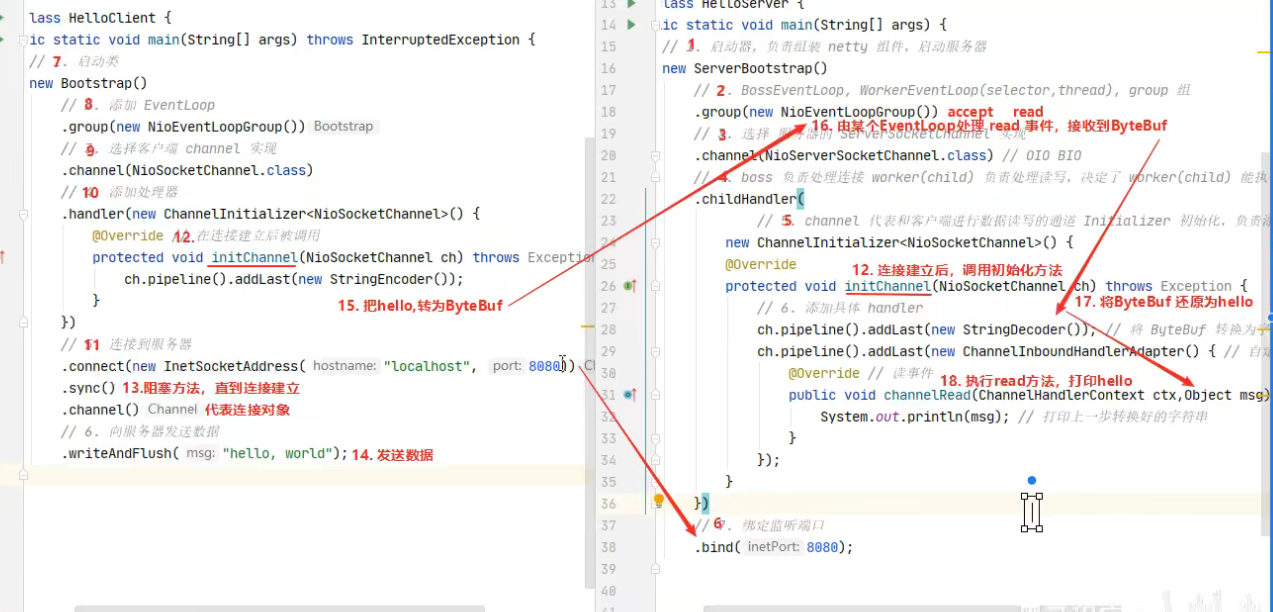
服务端代码
package com.example.nettytest01.netty;
import io.netty.bootstrap.ServerBootstrap;
import io.netty.channel.ChannelHandlerContext;
import io.netty.channel.ChannelInitializer;
import io.netty.channel.SimpleChannelInboundHandler;
import io.netty.channel.nio.NioEventLoopGroup;
import io.netty.channel.socket.nio.NioServerSocketChannel;
import io.netty.channel.socket.nio.NioSocketChannel;
import io.netty.handler.codec.string.StringDecoder;
public class HelloServer {
public static void main(String[] args) {
// 服务器端启动器 组装netty组件
new ServerBootstrap()
//包含线程和选择器
.group(new NioEventLoopGroup()) // 监听accept事件 找到对应的一个accept
//OIO BIO 选择服务器的 NioServerSocketChannel
.channel(NioServerSocketChannel.class)
//boss 处理连接 ,worker 处理读写 ,简单理解是 handler
.childHandler(
//Channel 数据读写通道 Initializer初始化器 添加别的handler
new ChannelInitializer<NioSocketChannel>() {
@Override // 在连接建立之后执行
protected void initChannel(NioSocketChannel nioSocketChannel) throws Exception {
//将传输来的数据转化为字符串 ,然后给下一个处理器 SimpleChannelInboundHandler
nioSocketChannel.pipeline().addLast(new StringDecoder()) ;
//自定义的Handler
nioSocketChannel.pipeline().addLast(new SimpleChannelInboundHandler<String>() {
//读事件 处理传过来的读事件 String:接收过来的数据
@Override
protected void channelRead0(ChannelHandlerContext channelHandlerContext, String s) throws Exception {
// 打印上一步处理好的字符串
System.out.println(s);
}
});
}
})
//监听端口
.bind(8080) ;
}
}
客户端代码
package com.example.nettytest01.netty;
import io.netty.bootstrap.Bootstrap;
import io.netty.channel.ChannelInitializer;
import io.netty.channel.nio.NioEventLoopGroup;
import io.netty.channel.socket.nio.NioSocketChannel;
import io.netty.handler.codec.string.StringEncoder;
public class HelloClient {
public static void main(String[] args) throws InterruptedException {
//启动类
new Bootstrap()
//添加EventLoop
.group(new NioEventLoopGroup()) //关注Accept
.channel(NioSocketChannel.class)
.handler(new ChannelInitializer<NioSocketChannel>() { //添加处理器 ,只有在连接建立才回执行initChannel()
//在连接建立后 被调用
@Override
protected void initChannel(NioSocketChannel nioSocketChannel) throws Exception { // 添加处理器
nioSocketChannel.pipeline().addLast(new StringEncoder()) ;
}
})
.connect("localhost",8080)
.sync() // 阻塞方法 ,知道连接建立
.channel() //代表一个channel
.writeAndFlush("hello word") ; // 把数据转为ByteBuf
}
}
res :

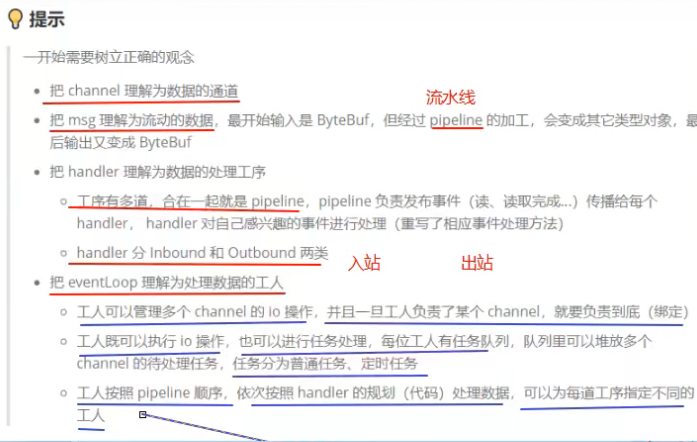
EventLoop
本质上就是个单线程执行器 同时维护了一个(selector :事件监听),里面的 这个线程里面 的run方法 处理源源不断的channel上的事件 。

EventLoop还是单线程 ,一个线程对应多个channel 。
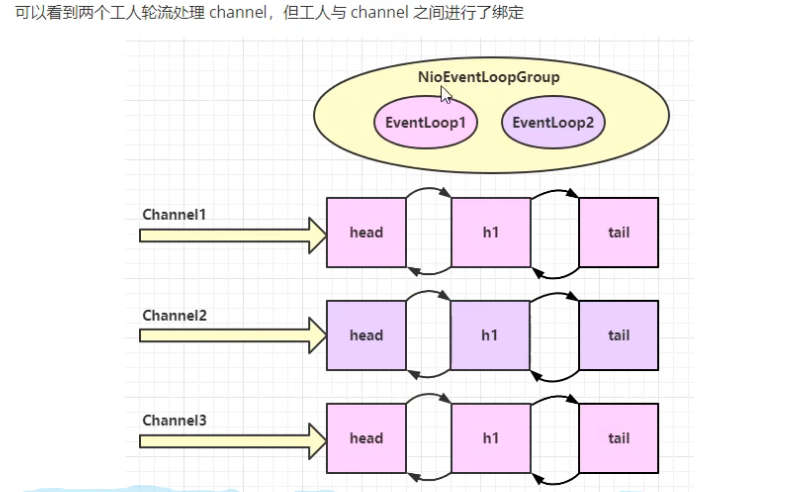
事件循环组
EventLoopGroup: 是一组 EventLoop ,channel 一般回调用EventLoopGroup的register方法绑定 其中一个EventLoop
后续就像结婚一样 ,以后所有Channel的io事件都由 EVentLoop来处理
一条通道绑定到一个工人身上

// 创建事件循环组 默认线程数 = 你 cup核心数*2
NioEventLoopGroup group = new NioEventLoopGroup(4); //io 普通任务 定时任务
while (true){
System.out.println(group.next());
}

提交任务
public static void main(String[] args) {
// 创建事件循环组 默认线程数 = 你 cup核心数*2
NioEventLoopGroup group = new NioEventLoopGroup(4); //io 普通任务 定时任务
//提交普通任务
group.next().submit(()->{
try {
Thread.sleep(1000);
} catch (InterruptedException e) {
e.printStackTrace();
}
}) ;
//提交定时任务
group.next().scheduleAtFixedRate(()->{
log.info("ok");
},0,1, TimeUnit.SECONDS) ;
log.debug("mian ");
}
为了防止单个线程io时间过长 , 需要独立出来一个 EventLoopGroup 专门处理io事情
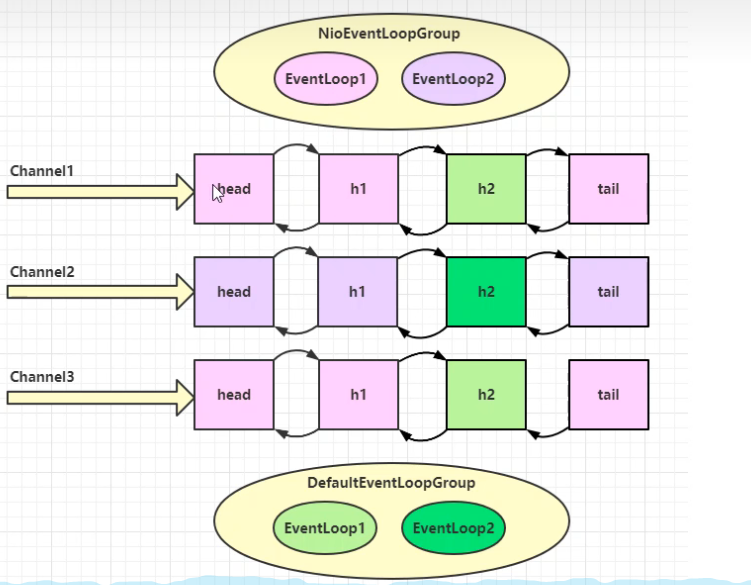
服务端
public class MyServer {
public static void main(String[] args) {
//处理耗时较长的Handler
DefaultEventLoopGroup defaultEventLoopGroup = new DefaultEventLoopGroup();
new ServerBootstrap()
// 1. NioEventLoopGroup:Boss 处理serverSockChannel 上的一个 accept 事件,
// 因为serverSockChannel只有一个。NioEventLoopGroup 所有只有一个线程
// 2. NioEventLoopGroup:woker 处理 sockChannel上的读写事件
.group(new NioEventLoopGroup(),new NioEventLoopGroup(2))
.channel(NioServerSocketChannel.class)
.childHandler(new ChannelInitializer<SocketChannel>() {
@Override
protected void initChannel(SocketChannel socketChannel) throws Exception {
// 执行读取 时间 ,让一个 defaultEventLoopGroup 进行关联 ,下面的用的就是
// defaultEventLoopGroup 中的线程 不是 new NioEventLoopGroup(2) 中的线程咯
// 说白了就是 分工细化
socketChannel.pipeline().addLast(defaultEventLoopGroup,"handler1 ",
new ChannelInboundHandlerAdapter() {
@Override
public void channelRead(ChannelHandlerContext ctx, Object msg) throws Exception {
ByteBuf buf = (ByteBuf) msg;
System.out.println(Thread.currentThread().getName() + " " + buf.toString(StandardCharsets.UTF_8));
ctx.fireChannelRead(msg) ; //将消息传给下一个handler
}
}).addLast(defaultEventLoopGroup,"handler2",new ChannelInboundHandlerAdapter(){
@Override
public void channelRead(ChannelHandlerContext ctx, Object msg) throws Exception {
ByteBuf buf = (ByteBuf) msg;
System.out.println(Thread.currentThread().getName() + " " + buf.toString(StandardCharsets.UTF_8));
}
});
}
})
.bind(8080);
}
}
客户端
public class MyClient {
public static void main(String[] args) throws IOException, InterruptedException {
Channel channel = new Bootstrap()
.group(new NioEventLoopGroup())
.channel(NioSocketChannel.class)
.handler(new ChannelInitializer<SocketChannel>() {
@Override
protected void initChannel(SocketChannel socketChannel) throws Exception {
socketChannel.pipeline().addLast(new StringEncoder());
}
})
.connect(new InetSocketAddress("localhost", 8080))
.sync()
.channel();
System.out.println(channel);
// 此处打断点调试,调用 channel.writeAndFlush(...);
System.in.read();
}
}
handler 中如何换人
第一个EventLoop 获取下一个EventLoop ,看是不是自己 , 是自己 这个任务就交给自己执行 ,
否则就交给 下一个EventLoop ;
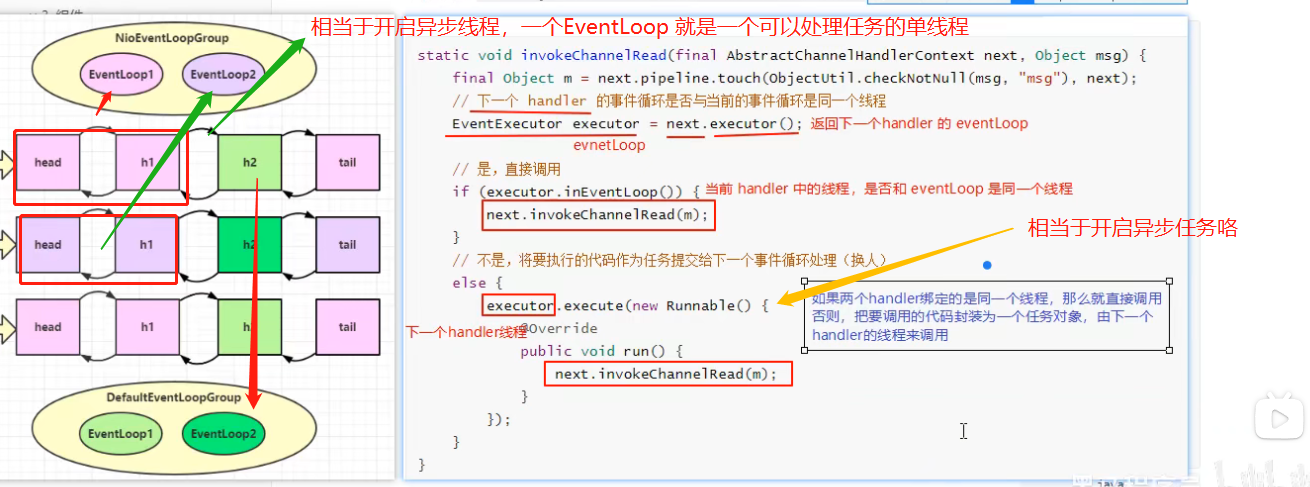
Channel
| close | 关闭 |
| closeFuture | 将channel关闭 |
| sync | 阻塞方法 ,直到连接建立,同步等待channel关闭 |
| addListener | 异步等待 channel关闭 |
| pipeline() | 添加处理器 |
| writer() | 将数据写入 |
| writeAndFlush | 将数据写入并且刷出 == writer() + flush() |
public class MyClient {
public static void main(String[] args) throws IOException, InterruptedException {
ChannelFuture channelFuture = new Bootstrap()
.group(new NioEventLoopGroup())
.channel(NioSocketChannel.class)
.handler(new ChannelInitializer<SocketChannel>() {
@Override
protected void initChannel(SocketChannel socketChannel) throws Exception {
socketChannel.pipeline().addLast(new StringEncoder());
}
})
// 1. 连接到服务器 mian线程 将连接服务器的请求交给别的线程 去执行 -》 异步非阻塞
// 是另一个线程建立的连接 ( nio 线程 ) 大约 1 s
.connect(new InetSocketAddress("localhost", 8080));
// 如果不使用此方法 , 主线程会真正的执行 channel.writeAndFlush("ni hao ya mememem ");
// 但是此时 主线程 还没有和 服务器建立连接 就会报错。没有管道向管道输出
channelFuture.sync() ;
Channel channel = channelFuture.channel();
System.out.println(channel);
for (int i = 0 ;i <10;i++){
Thread.sleep(3000);
channel.writeAndFlush("ni hao ya mememem ");
}
// 此处打断点调试,调用 channel.writeAndFlush(...);
System.in.read();
}
}
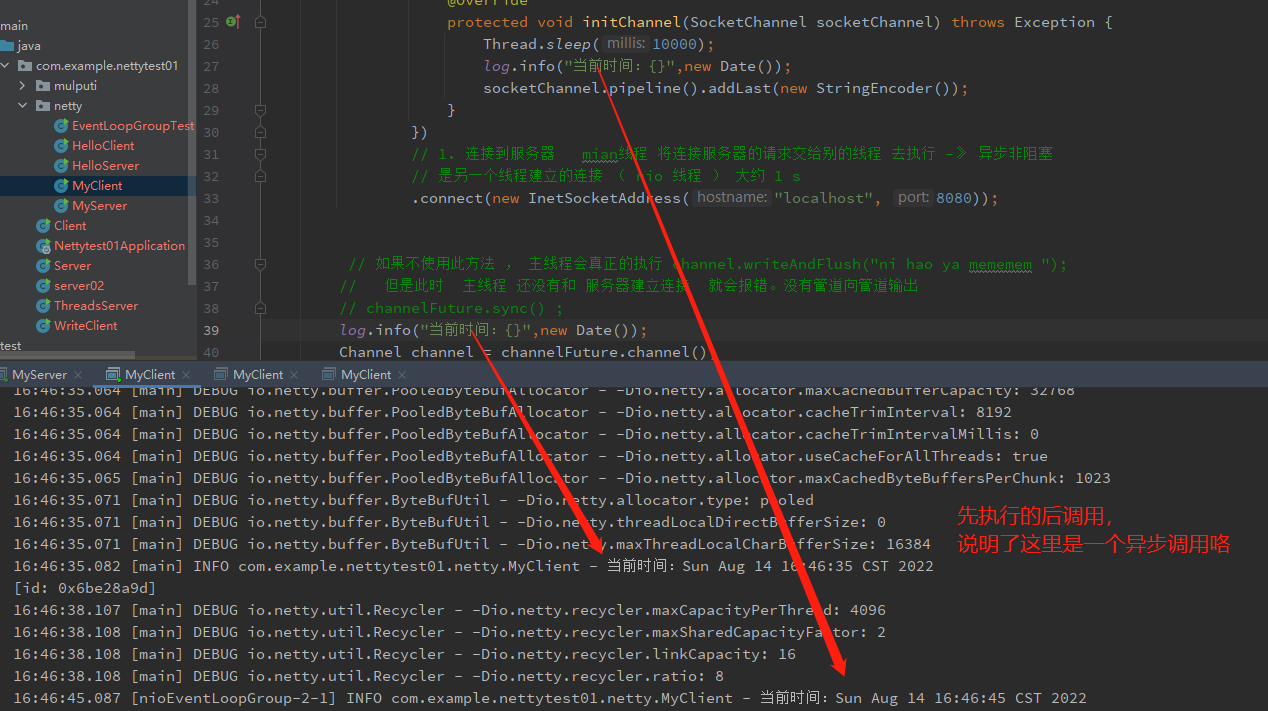
上面第 36 行是错的 !!
我试了一下也是,感觉应该是write方法会等到连接建立好了再写?因为另外一个线程在执行connect方法,只不过main这边获得的channel只是还没建立连接,但是已经有了,到了write
优雅的循环向服务器写,并且优雅的异步关闭客户端
@Slf4j
public class EventLoopGroupTest02 {
public static void main(String[] args) throws InterruptedException {
ChannelFuture channelFuture = new Bootstrap()
.group(new NioEventLoopGroup())
.channel(NioSocketChannel.class)
.handler(new ChannelInitializer<NioSocketChannel>() {
@Override
protected void initChannel(NioSocketChannel ch) throws Exception {
ch.pipeline().addLast(new StringEncoder());
}
})
.connect(new InetSocketAddress("localhost",8080)) ;
Channel channel = channelFuture.sync().channel();
new Thread(()->{
Scanner scanner = new Scanner(System.in);
while (true){
String line = scanner.nextLine();
log.info("当前时间:{},当前线程:{}",new Date(),Thread.currentThread().getName());
if (line.equals("q")){
channel.close(); // channel.close()是一个异步操作 !!假设3秒执行完毕关闭管道
// log.info("处理关闭之后的 操作 "); 在第一秒就执行了
// log.info("处理关闭之后的 操作 ");
break;
}
log.info("当前时间:{},当前线程:{}",new Date(),Thread.currentThread().getName());
channel.writeAndFlush(line) ;
}
},"input").start();
//处理关闭方法 -- 善后处理
ChannelFuture closeFuture = channel.closeFuture();
/*
同步执行关闭 , 在主线程上执行善后处理
log.info("waiting close....");
//阻塞当前线程 ,只有当 channel.close(); 执行之后才能继续向下运行
closeFuture.sync() ;
log.info("开始执行善后方法咯...."); */
//异步执行执行善后方法 channelFuture closeFuture
closeFuture.addListener(
// 回调对象 执行关闭方法 在异步线程上执行 善后处理
new ChannelFutureListener() {
@Override
public void operationComplete(ChannelFuture channelFuture) throws Exception {
log.info("当前时间:{},当前线程:{}",new Date(),Thread.currentThread().getName());
log.info("开始执行善后方法咯....");
}
});
}
}
为什么要异步
- 任务划分
- 异步没有缩短响应时间 ,反而有所增加
- 合理任务拆分


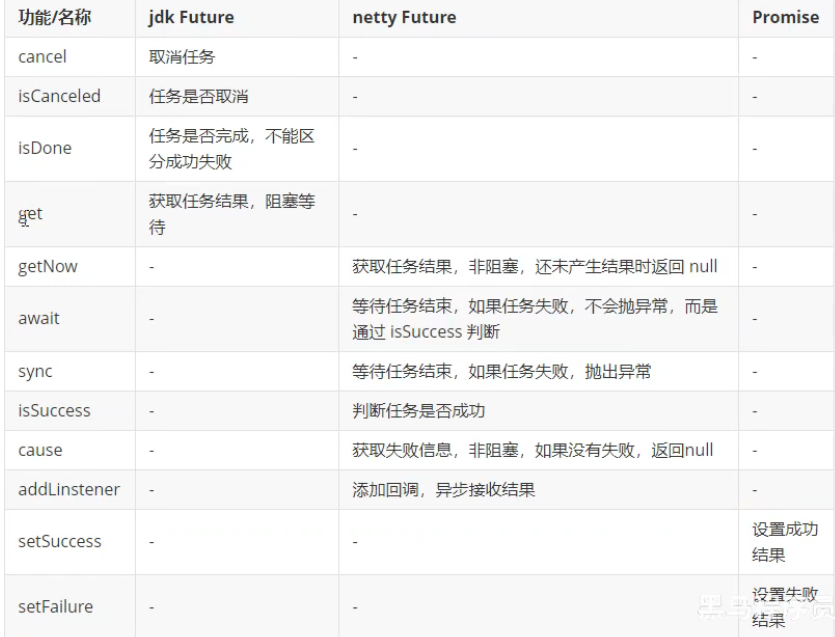
Jdk 同步获取异步任务结果
future 可以看作一个书包 , 异步线程是你同学 ,你同学往你书包里面放 integer ,放完了 你调用书包的get()方法 获得 integer
future 就是在线程间 传递结果的容器
@Slf4j
public class JdkFuture {
//异步提交任务 主线程同步获取结果
public static void main(String[] args) throws ExecutionException, InterruptedException {
ExecutorService executorService = Executors.newFixedThreadPool(2);
Future<Integer> future = executorService.submit(new Callable<Integer>() {
@Override
public Integer call() throws Exception {
Thread.sleep(2000);
return 50;
}
});
log.info("waiting...res:{}",new Date(),Thread.currentThread().getName());
//主线程通过futer 获取结果
Integer integer = future.get();
log.info("当前时间:{},当前线程:{},获取的结果:{}",new Date(),Thread.currentThread().getName(),integer);
}
}
netty NioEventLoopGroup中的 线程获取结果
@Slf4j
public class NettyFuter {
public static void main(String[] args) throws ExecutionException, InterruptedException {
NioEventLoopGroup loopGroup = new NioEventLoopGroup();
EventLoop eventLoop = loopGroup.next();
Future<Integer> future = eventLoop.submit(new Callable<Integer>() {
@Override
public Integer call() throws Exception {
log.info("当前时间:{},当前线程:{}", new Date(), Thread.currentThread().getName());
log.info("正在获取结果");
Thread.sleep(3000);
return 10;
}
});
log.info("主线程正在获取结果");
log.info("当前时间:{},当前线程:{},获取的结果:{}",new Date(),Thread.currentThread().getName(),future.get());
}
}
异步获取结果
@Slf4j
public class NettyFuter {
public static void main(String[] args) throws ExecutionException, InterruptedException {
NioEventLoopGroup loopGroup = new NioEventLoopGroup();
EventLoop eventLoop = loopGroup.next();
Future<Integer> future = eventLoop.submit(new Callable<Integer>() {
@Override
public Integer call() throws Exception {
log.info("当前时间:{},当前线程:{}", new Date(), Thread.currentThread().getName());
log.info("正在获取结果");
Thread.sleep(3000);
return 10;
}
});
/* log.info("主线程正在获取结果");
log.info("当前时间:{},当前线程:{},获取的结果:{}",new Date(),Thread.currentThread().getName(),future.get());
*/
// 异步获取结果
future.addListener(new GenericFutureListener<Future<? super Integer>>() {
@Override
public void operationComplete(Future<? super Integer> future) throws Exception {
//getNow 立刻获得结果 非阻塞 ,因为 这是触发回调执行的 ,结果已经有了
log.info("当前时间:{},当前线程:{},获取的结果:{}",new Date(),Thread.currentThread().getName(),future.getNow());
}
}) ;
}
}

promise 同步获取结果
promise 相当于是一个书包 ,但是这个书包是我们自己手动创建的
@Slf4j
public class PromiseNetty {
public static void main(String[] args) throws ExecutionException, InterruptedException {
EventLoop group = new NioEventLoopGroup().next();
DefaultPromise<Integer> promise = new DefaultPromise<>(group);
new Thread(()->{
// 完成计算后向promise 中放结果
log.info("开始计算~~");
try {
Thread.sleep(5000);
} catch (InterruptedException e) {
e.printStackTrace();
}
//往包里面放结果
promise.setSuccess(8) ;
}).start();
log.info("这在等待结果,当前时间:{},当前线程:{}", new Date(), Thread.currentThread().getName());
// 同步获取结果
//promise.get() 是同步阻塞 1.主线程获取结果 2.没有结果这里会一直阻塞
log.info("这在等待结果,当前时间:{},当前线程:{},结果是:{}", new Date(), Thread.currentThread().getName(),promise.get());
log.info("我已经获取结果咯,当前时间:{},当前线程:{}", new Date(), Thread.currentThread().getName());
}
}

Handler & Pipeline
分为入站 和出战 handler
- 入站Handler : ChannelInboundHandlerAdapter 的子类 ,用来读取客户端数据 ,写回结果
- 出站Handler : ChannelOutboundHandlerAdapter 的子类 ,用来 对写回结果进行加工
客户端
@Slf4j
public class EventLoopGroupTest02 {
public static void main(String[] args) throws InterruptedException {
NioEventLoopGroup eventExecutors = new NioEventLoopGroup();
ChannelFuture channelFuture = new Bootstrap()
.group(eventExecutors)
.channel(NioSocketChannel.class)
.handler(new ChannelInitializer<NioSocketChannel>() {
@Override
protected void initChannel(NioSocketChannel ch) throws Exception {
ch.pipeline().addLast(new StringEncoder());
}
})
.connect(new InetSocketAddress("localhost",8080)) ;
Channel channel = channelFuture.sync().channel();
new Thread(()->{
Scanner scanner = new Scanner(System.in);
while (true){
String line = scanner.nextLine();
log.info("当前时间:{},当前线程:{}",new Date(),Thread.currentThread().getName());
if (line.equals("q")){
channel.close(); // channel.close()是一个异步操作 !!假设3秒执行完毕关闭管道
// log.info("处理关闭之后的 操作 "); 在第一秒就执行了
// log.info("处理关闭之后的 操作 ");
break;
}
log.info("当前时间:{},当前线程:{}",new Date(),Thread.currentThread().getName());
channel.writeAndFlush(line) ;
}
},"input").start();
//处理关闭方法 -- 善后处理
ChannelFuture closeFuture = channel.closeFuture();
/*
同步执行关闭 , 在主线程上执行善后处理
log.info("waiting close....");
//阻塞当前线程 ,只有当 channel.close(); 执行之后才能继续向下运行
closeFuture.sync() ;
log.info("开始执行善后方法咯...."); */
//异步执行执行善后方法 channelFuture closeFuture
// 回调对象 执行关闭方法 在异步线程上执行 善后处理
closeFuture.addListener((ChannelFutureListener) channelFuture1 -> {
log.info("当前时间:{},当前线程:{}",new Date(),Thread.currentThread().getName());
log.info("开始执行善后方法咯....");
log.info("eventExecutors还没关闭哦....下面执行 异步线程组的关闭!!");
// eventExecutors.shutdownGracefully() 执行关闭 ,把没发完的数据发完
eventExecutors.shutdownGracefully() ;
});
}
}
服务端
@Slf4j
public class TsetPeline {
public static void main(String[] args) {
new ServerBootstrap()
.group(new NioEventLoopGroup())
.channel(NioServerSocketChannel.class)
.childHandler(new ChannelInitializer<NioSocketChannel>() {
@Override
protected void initChannel(NioSocketChannel nioSocketChannel) throws Exception {
// 1. 通过channel 拿到 pipeline
ChannelPipeline pipeline = nioSocketChannel.pipeline();
// 添加处理器 head <-> h1 (pipeline.addLast()) <-> h2 <->tail
pipeline.addLast("h1",new ChannelInboundHandlerAdapter(){
@Override
// 入站handler 一般关注读事件
public void channelRead(ChannelHandlerContext ctx, Object msg) throws Exception {
log.info("h1,这里是ChannelInboundHandlerAdapter 当前线程:{}",Thread.currentThread().getName());
log.info("当前时间:{},当前线程:{}", new Date(), Thread.currentThread().getName());
ByteBuf name = (ByteBuf) msg ;
Person student = new Person(name.toString(Charset.defaultCharset()));
// super.channelRead(ctx,student) == ctx.fireChannelRead(msg) 将数据传递给下一个handler
super.channelRead(ctx,student);
}
});
pipeline.addLast("h2",new ChannelInboundHandlerAdapter(){
@Override
// 入站handler 一般关注读事件
public void channelRead(ChannelHandlerContext ctx, Object msg) throws Exception {
log.info("h2,这里是ChannelInboundHandlerAdapter 当前线程:{}",Thread.currentThread().getName());
log.info("h2获得了信息:{}",(Person)msg);
super.channelRead(ctx,msg);
// 注意千万别是 ctx : ctx 是向前找 ChannelOutboundHandlerAdapter ,
//nioSocketChannel 是从当前往后找ChannelOutboundHandlerAdapter
nioSocketChannel.writeAndFlush(ctx.alloc().buffer().writeBytes("ni hao ya client".getBytes()));
}
});
pipeline.addLast("h3",new ChannelOutboundHandlerAdapter(){
//出站处理器 只有向channel 写数据才会触发
@Override
public void write(ChannelHandlerContext ctx, Object msg, ChannelPromise promise) throws Exception {
log.info("h3");
super.write(ctx,msg,promise);
}
}) ;
pipeline.addLast("h4",new ChannelOutboundHandlerAdapter(){
//出站处理器 只有向channel 写数据才会触发
@Override
public void write(ChannelHandlerContext ctx, Object msg, ChannelPromise promise) throws Exception {
log.info("h4");
super.write(ctx,msg,promise);
}
}) ;
}
})
.bind(8080) ;
}
@Data
@ToString
@AllArgsConstructor
static class Person{
private String name ;
}
}
ctx : ctx 是向前找 ChannelOutboundHandlerAdapter ,
//nioSocketChannel 是从当前往后找ChannelOutboundHandlerAdapter

ByteBuf
ByteBuf优势
1.池化: ByteBuf可以重用, 类似于java的常量池,减少内存溢出
2. 读写指针分离:不需要像ByteBuffer切换读写指针
3.可以自动扩容
4.支持链式调用
5.很多地方体现零拷贝(不用复制数据的拷贝,但是切记 设置retaiin() :引用计数){下面会具体使用}
可以动态扩容
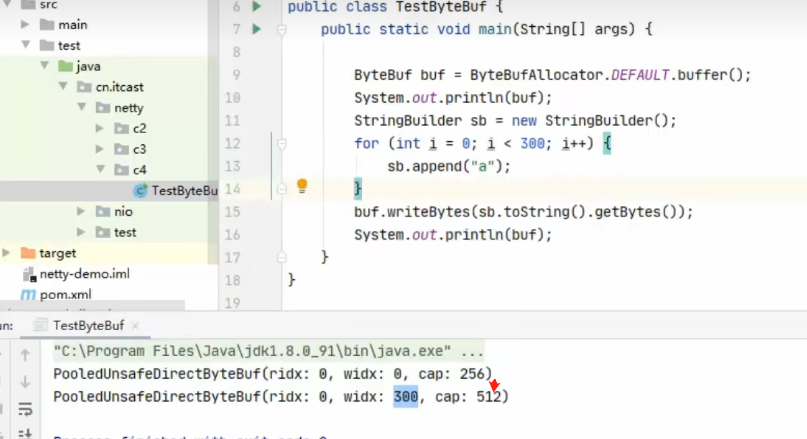

默认容量太大了 ,可以指定一个 最大容量,超过容量会申请扩容
直接内存VS 堆内存
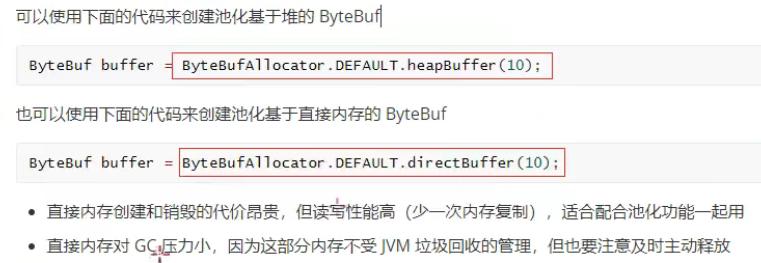
默认是直接内存的!!
池化vs非池化
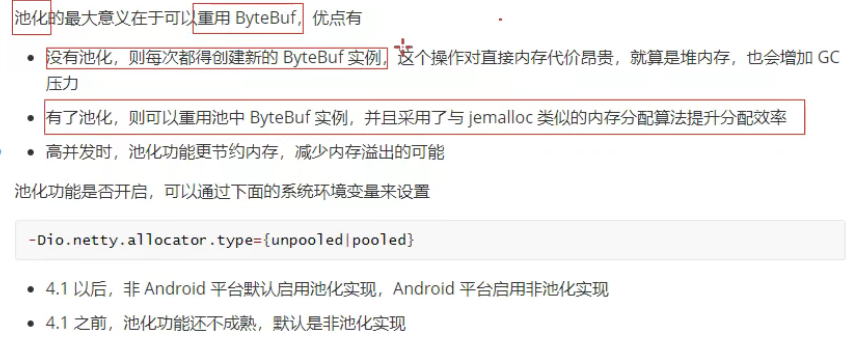
有点类似于 线程池,默认开启

写入方法
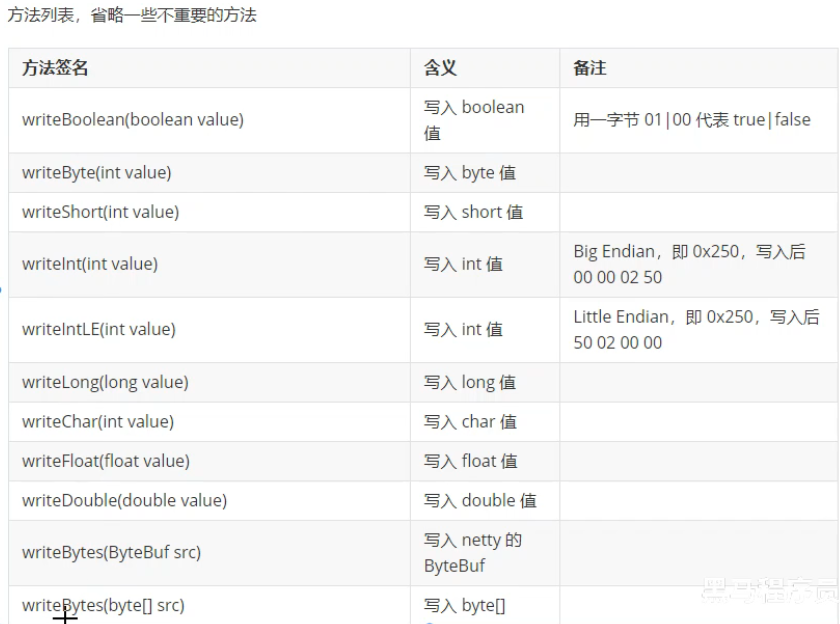
Big Endian 大端(网络编程一般大端): 先写高位再写地位
Little Endian 小端:相反
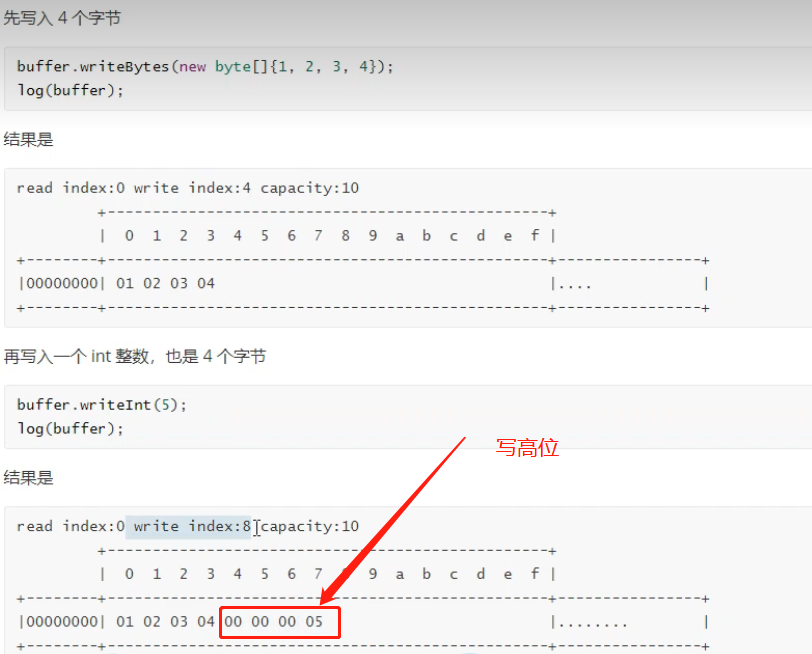
扩容

读取
例如读取四个字节

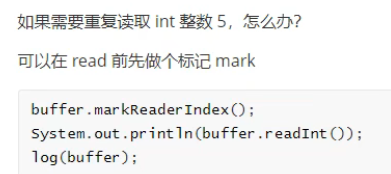

retain & release
UnpooledHeapByteBuf 使用的是JVM内存 只需要GC回收内存
UnpooledDirByteBuf 使用的是直接内存 需要特殊方法进行回收
PooledByteBuf 和它的子类使用了池化机制 ,需要更加复杂的规则回收

有点像信号量



在handlerAdapter调用链中 故谁最后使用了ByteBuf谁释放
head :实现了 处理入站 和出站 Hadler
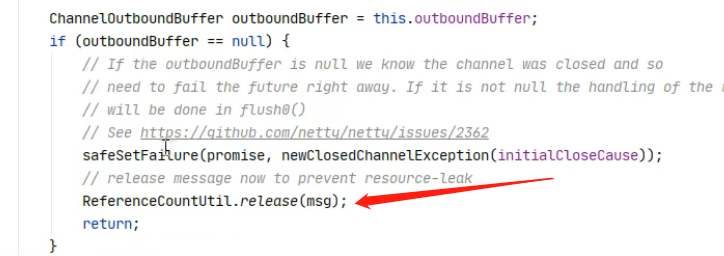
slice
零拷贝: 网络传输数据的时候 数据不经过java内存直接从文件传到socket,减少多次内存复制,提高传输性能
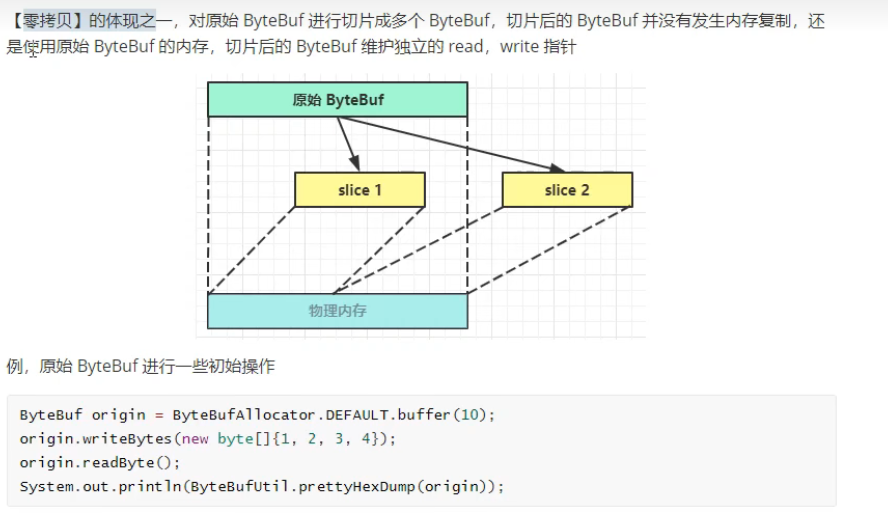
public static void main(String[] args) {
ByteBuf buffer = ByteBufAllocator.DEFAULT.buffer(16, 20);
buffer.writeBytes(new byte[]{0,1, 2, 3, 4, 5, 6, 7, 8, 9, 10}) ;
ByteBuf s1 = buffer.slice(0, 5);
ByteBuf s2 = buffer.slice(6, 10);
log.debug("s1:{}",s1);
log.debug("s2:{}",s2);
}
切片不能增加数据 会报错
2.假如buf被release 切片数据也会消失。
public static void main(String[] args) {
ByteBuf buffer = ByteBufAllocator.DEFAULT.buffer(16, 20);
buffer.writeBytes(new byte[]{0,1, 2, 3, 4, 5, 6, 7, 8, 9, 10}) ;
ByteBuf s1 = buffer.slice(0, 5);
ByteBuf s2 = buffer.slice(6, 10);
//buffer 的引用计数加一 , buffer.release() 不会释放
// 但是调用2 次就会被释放
s1.retain() ;
log.debug("s1:{}",s1);
log.debug("s2:{}",s2);
buffer.release() ;
buffer.release() ;
log.debug("s1:{}",s1);
log.debug("s2:{}",s2);
log.debug("buffer:{}",buffer);
}

做一个切片 调用一个 slice.retain()(buffer的引用计数器加一) ,使用完毕后 记得 buffer.release() 一次 ,避免 别人调用 buffer.release() 将你的数据清空
duplicate
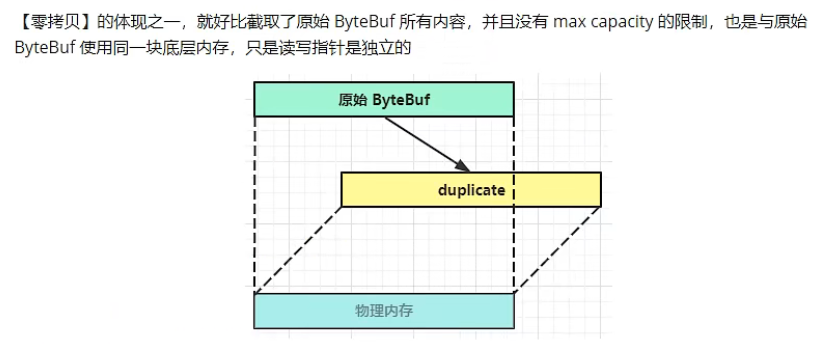
零拷贝跟 slice相似 ,但是不同的是 duplicate (是复制的意思 ),截取的是从头到尾
copy
将底层数据进行深拷贝,因此无论读写 , 都与Bytebuf无关
CompositeByteBuf
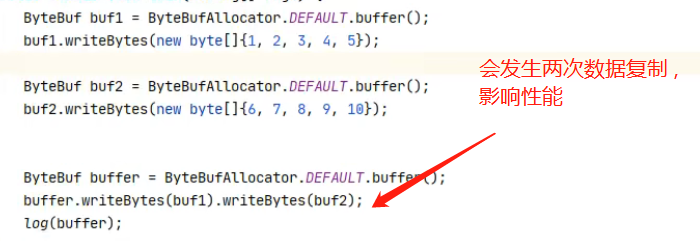
CompositeByteBuf:避免了数据的复制
// increaseWriterIndex: 设置是否自动增长 不然他的 widx(写指针)不动
//CompositeByteBuf(ridx: 0, widx: 0, cap: 16, components=2)-》
//CompositeByteBuf(ridx: 0, widx: 16, cap: 16, components=2)
// 也需要注意引用计数问题!!! ,避免引用计数被减到零
ByteBuf buffer1 = ByteBufAllocator.DEFAULT.buffer(16, 20);
buffer1.writeBytes(new byte[]{0,1, 2, 3, 4, 5, 6, 7, 8, 9, 10}) ;
ByteBuf buffer2= ByteBufAllocator.DEFAULT.buffer(16, 20);
buffer1.writeBytes(new byte[]{0,1, 2, 3, 4}) ;
//组合两个buffer且 不发生复制
CompositeByteBuf compositeBuffer = ByteBufAllocator.DEFAULT.compositeBuffer();
// increaseWriterIndex: 设置是否自动增长 不然他的 widx(写指针)不动
//CompositeByteBuf(ridx: 0, widx: 0, cap: 16, components=2)-》
//CompositeByteBuf(ridx: 0, widx: 16, cap: 16, components=2)
compositeBuffer.addComponent(true,buffer1);
compositeBuffer.addComponent(true,buffer2) ;
log.info("compositeBuffer:{}",compositeBuffer);























 625
625











 被折叠的 条评论
为什么被折叠?
被折叠的 条评论
为什么被折叠?








